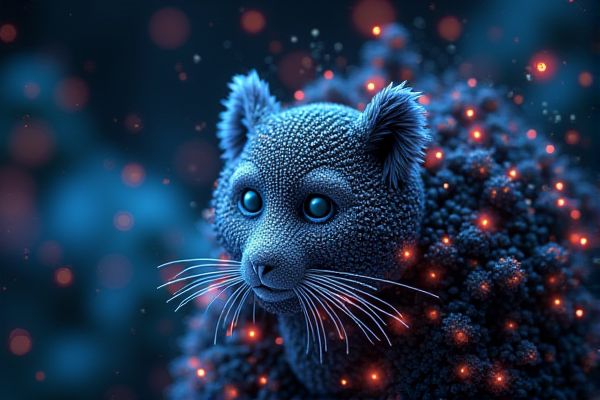
AI tools enhance the creative design process by generating diverse design options quickly, allowing designers to explore myriad possibilities without extensive manual effort. Machine learning algorithms analyze trends and user preferences, providing insights that help tailor designs to specific audiences. AI-driven applications can automate repetitive tasks, freeing up time for designers to focus on more innovative aspects of their work. Collaborative platforms powered by AI facilitate communication among team members, ensuring a more cohesive and efficient design workflow.
AI usage in creative designs
Generative Design
AI can enhance creative designs through generative design techniques by producing innovative solutions that a human designer may not envision. For instance, architectural firms like Zaha Hadid Architects utilize AI algorithms to explore a vast range of design possibilities, optimizing for factors like aesthetics and functionality. This technology offers the advantage of rapid prototyping, which allows designers to iterate quickly and refine their concepts. Embracing AI in creative processes can lead to unique and efficient designs that push the boundaries of traditional artistry.
Neural Style Transfer
Neural Style Transfer enables artists to blend their unique styles with various content images, resulting in innovative visual creations. This technique can enhance graphic design projects by offering fresh perspectives and artistic combinations. For example, a designer might use Neural Style Transfer to integrate the styles of famous painters with modern photography. Such applications present an opportunity for creative expression and can elevate the marketability of design work.
AI-Driven Animation
AI usage in creative designs offers the potential for streamlined workflows and enhanced efficiency. For instance, AI-driven animation tools can generate intricate scenes quickly, allowing artists to focus on higher-level conceptual tasks. This technology can identify patterns and trends, suggesting design elements that align with current aesthetic preferences. The incorporation of AI may lead to innovative outcomes that might not be possible through traditional methods alone.
Automated Image Editing
AI in creative design introduces the potential for enhanced efficiency in processes such as automated image editing. Tools like Adobe Photoshop's AI features streamline tasks, allowing designers to focus on more complex elements of their projects. This can lead to improved productivity and reduced turnaround times for clients. Companies specializing in digital marketing may find a competitive advantage by integrating AI solutions into their design workflows.
Virtual Reality Prototyping
AI can enhance creative designs by providing data-driven insights that streamline the design process. For instance, tools like Adobe Sensei can analyze user preferences and suggest design elements that might resonate more with target audiences. In Virtual Reality prototyping, AI can simulate various user interactions to optimize product usability and aesthetics. This integration can result in a more efficient development process and a higher likelihood of market success.
AI-Assisted Illustration
AI-assisted illustration has the potential to enhance creativity in design by providing unique and diverse artistic styles. Artists can leverage tools like DALL-E to generate inspiration or create drafts, streamlining their workflow. This technology can also enable quicker iterations, allowing creatives to experiment with variations more efficiently. The chance to blend human intuition with AI's analytical capabilities may lead to innovative results in creative projects.
Design Personalization
AI can enhance creative designs through personalized user experiences. For example, fashion brands like Nike utilize AI to tailor designs based on customer preferences, increasing user satisfaction. This technology offers the potential for significantly improving engagement by delivering unique and relevant designs. The chance of gaining a competitive edge in the market is greater as companies adopt AI-driven personalization strategies.
Intelligent Color Matching
AI can enhance creative designs through intelligent color matching, providing artists and designers with tailored palettes that align with current trends. Platforms like Adobe Creative Cloud have integrated AI tools that analyze user preferences and suggest color combinations that resonate with their work. This capability increases efficiency, allowing creators to focus more on innovation rather than manual selection. The potential for AI to revolutionize design processes opens doors for new artistic expressions and unique visual experiences.
Content-Aware Scaling
AI can enhance creative designs by automating tasks such as Content-Aware Scaling, allowing designers to resize images intelligently without losing essential details. This technology increases the chance of producing visually appealing artwork more efficiently. For instance, graphic design platforms like Adobe Photoshop leverage AI capabilities to provide tools that assist in creative workflows. The potential for improved design accuracy and speed opens up new opportunities for artists and designers in various fields.
Predictive Trend Analysis
AI usage in creative designs can enhance the efficiency and originality of artistic projects. Predictive trend analysis allows designers to anticipate shifts in consumer preferences, making their work more relevant. For instance, fashion designers can leverage AI to analyze past trends and predict future styles, giving them a competitive edge. This integration may lead to higher engagement and sales, showcasing the potential advantages of AI in creative industries.
 techknowy.com
techknowy.com